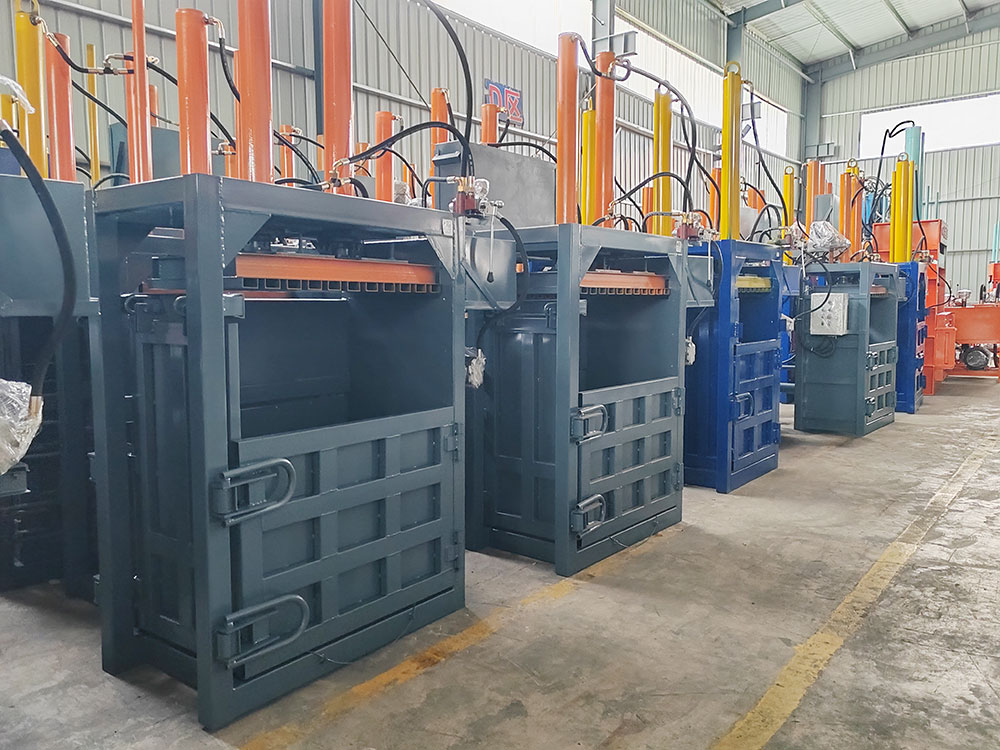Plastic waste piles up quickly? Storage costs soaring? A vertical baler compacts recyclables efficiently, cutting your expenses fast.
A vertical plastic baler machine uses hydraulic pressure to compress plastic waste into dense, stackable bales. It reduces volume by 80%, lowers handling costs, and streamlines recycling operations – ideal for factories and recycling centers.

Now, let’s explore specialized solutions for different plastic types. See how these machines address your unique challenges.
How Can a Vertical PET Bottle Baler Transform Your Recycling?
PET bottles overflowing? Storage space vanishing? Compact them instantly with dedicated machinery.
A vertical PET bottle baler crushes containers into uniform bales using hydraulic force. It prevents bottle rebound, achieves up to 10:1 compression ratio, and produces export-ready bales compatible with recycling facilities.
Core Advantages for Bottle Recycling
Eliminating air pockets is crucial when baling PET. Our balers feature:
- Pre-crusher systems – Flattens bottles before compression
- Anti-bounce plates – Stops bottles springing back
- Pressure sensors – Automatically optimizes bale density
Below key performance differences versus manual handling:
| Factor | Manual Handling | With Baler |
|---|---|---|
| Volume Reduction | None | 90% reduction |
| Labor Hours | 8 hours/ton | 1 hour/ton |
| Storage Space | 100 sq ft/ton | 10 sq ft/ton |
I recall a beverage factory in Osaka. Their staff slipped daily hauling loose bottles. After installing our PET baler? Workplace injuries dropped 70% while output doubled.
Maintenance Tips
- Weekly: Check hydraulic oil levels
- Monthly: Inspect safety interlock switches
- Annual: Replace pressing chamber liners
Need specific throughput data? WhatsApp us direct for machine videos and test reports.
Why Use a Vertical Baler for Plastic Film Waste?
Sticky film jamming equipment? Workers battling tangled messes? Target this problem specifically.
A vertical baler for plastic film isolates stretchy materials using specialized feeding systems. Its anti-wrap rollers prevent entanglement while creating theater-tight bales that won’t unravel during transport.

Overcoming Film Challenges
Film requires gradual compression cycles. Standard balers fail because:
- Film traps air pockets
- Static causes material adhesion
- Uneven tension causes bale collapse
Our solutions:
- Stepped compression tech: Incremental pressure increases
- Moisture control: Reduces static electricity buildup
- Bale strapping stations: Secures bale integrity
During Mexico’s rainy season, a packaging plant had wet film clogging their machine. We added drainage grooves and heated chambers – waste processing resumed within hours.
Optimal Settings Guide
| Film Type | Pressure (PSI) | Cycle Time |
|---|---|---|
| LDPE | 2,500 | 90 seconds |
| PP Woven | 3,200 | 110 seconds |
| PVC Shrink | 1,800 | 75 seconds |
See the density test for your film? Send samples to our lab – WhatsApp us direct for shipping details.
Is a Plastic Waste Baler Suitable for Mixed Streams?
Contaminated recyclables slowing sorting? Combine materials safely with adaptive machinery.
A vertical baler for plastic waste handles mixed PET/PP/HDPE streams. It incorporates debris-resistant valves and adjustable pressure profiles, ideal for municipal facilities with unpredictable waste composition.
Critical Engineering Features
When dealing with unknowns, these components prevent failure:
- Hardox 600 blades: Cuts through metal contaminants
- Overload protection: Halts instantly if jammed
- Removable screens: For bolt/nail extraction
ShunYin’s Nashville client processed garden waste bags filled with sand. Standard balers seized within weeks. We installed:
- Magnetic separators
- Bottom discharge ports
- Reinforced main beams
Their machine now runs error-free for 12+ months.
Material Combination Table
| Waste Mix | Max Contamination Level | Bale Weight |
|---|---|---|
| PET + Labels | 8% paper | 300 kg |
| HDPE + Caps | 5% metal | 450 kg |
| Film + Residue | 10% organics | 200 kg |
Struggling with unique waste streams? Our team designs custom solutions. Connect via WhatsApp us direct.
What Makes HDPE Bottle Balers Different?
Bulky jugs refusing to compact? Volume reduction falling short? Solve HDPE’s stubborn rigidity.
A vertical baler for HDPE bottles incorporates dual-stage compression. Pre-crushing chambers first crack rigid walls before main cylinders achieve maximum density – yielding 900kg/m³ bales accepted globally.

Specialized Compression Mechanics
HDPE requires targeted force application:
Stage 1: Pre-break cycle
- Side-mounted teeth pierce bottle walls
- Air escapes via vent holes
- Force: ~1,500 PSI
Stage 2: High-density compression
- Hydraulic ram exerts 3,800+ PSI
- Pressure held for 60 seconds
- Bale binders auto-tension straps
Canadian recyclers saved 40% on shipping after switching to our HDPE baler. Their bale dimensions perfectly matched container specifications.
HDPE vs. PET Performance
| Characteristic | HDPE | PET |
|---|---|---|
| Minimum Pressure | 3,500 PSI | 2,200 PSI |
| Cycle Time | 130 sec | 85 sec |
| Bale Density | 900 kg/m³ | 750 kg/m³ |
Upgrade your HDPE processing? We engineer machines meeting IPC and EU directives. Let’s discuss certifications.
Conclusion
Vertical balers save space and costs for every plastic type. Choosing the right design boosts recycling profits – contact us for tailored solutions.








